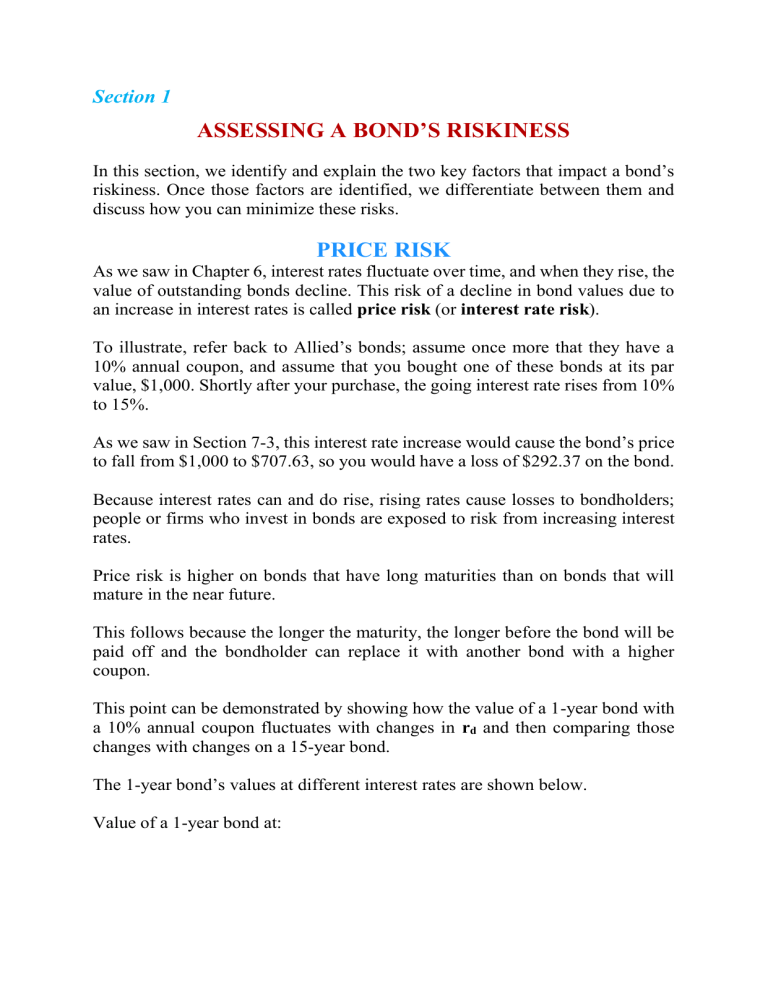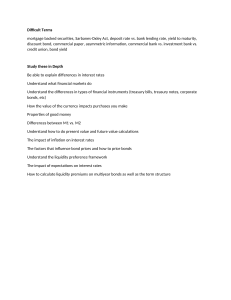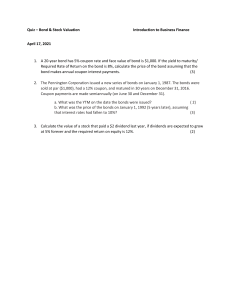
Section 1 ASSESSING A BOND’S RISKINESS In this section, we identify and explain the two key factors that impact a bond’s riskiness. Once those factors are identified, we differentiate between them and discuss how you can minimize these risks. PRICE RISK As we saw in Chapter 6, interest rates fluctuate over time, and when they rise, the value of outstanding bonds decline. This risk of a decline in bond values due to an increase in interest rates is called price risk (or interest rate risk). To illustrate, refer back to Allied’s bonds; assume once more that they have a 10% annual coupon, and assume that you bought one of these bonds at its par value, $1,000. Shortly after your purchase, the going interest rate rises from 10% to 15%. As we saw in Section 7-3, this interest rate increase would cause the bond’s price to fall from $1,000 to $707.63, so you would have a loss of $292.37 on the bond. Because interest rates can and do rise, rising rates cause losses to bondholders; people or firms who invest in bonds are exposed to risk from increasing interest rates. Price risk is higher on bonds that have long maturities than on bonds that will mature in the near future. This follows because the longer the maturity, the longer before the bond will be paid off and the bondholder can replace it with another bond with a higher coupon. This point can be demonstrated by showing how the value of a 1-year bond with a 10% annual coupon fluctuates with changes in rd and then comparing those changes with changes on a 15-year bond. The 1-year bond’s values at different interest rates are shown below. Value of a 1-year bond at: You would obtain the first value with a financial calculator by entering N = 1, I/YR = 5, PMT = 100, and FV = 1000 and then pressing PV to get $1,047.62. With all the data still in your calculator, enter I/YR = 10 to override the old I/YR = 5, and press PV to find the bond’s value at a 10% rate; it drops to $1,000. Then enter I/YR = 15, and press the PV key to find the last bond value, $956.52. The effects of increasing rates on the 15-year bond value as found earlier in Section 7-3 can be compared with the just-calculated effects for the 1-year bond. This comparison is shown in Figure 7.3, where we show bond prices at several rates and then plot those prices on the graph. Compared to the 1-year bond, the 15-year bond is far more sensitive to changes in rates. At a 10% interest rate, both the 15-year and 1-year bonds are valued at $1,000. When rates rise to 15%, the 15-year bond falls to $707.63, but the 1-year bond falls only to $956.52. The price decline for the 1-year bond is only 4.35%, while that for the 15-year bond is 29.24%. For bonds with similar coupons, this differential interest rate sensitivity always holds true—the longer a bond’s maturity, the more its price changes in response to a given change in interest rates. Thus, even if the risk of default on two bonds is exactly the same, the one with the longer maturity is typically exposed to more risk from a rise in interest rates. The logical explanation for this difference in price risk is simple. Suppose you bought a 15-year bond that yielded 10%, or $100 a year. Now suppose interest rates on comparable-risk bonds rose to 15%. You would be stuck receiving only $100 of interest for the next 15 years. On the other hand, had you bought a 1-year bond, you would have earned a low return for only 1 year. At the end of the year, you would have received your $1,000 back; then you could have reinvested it and earned 15%, or $150 per year, for the next 14 years. REINVESTMENT RISK As we saw in the preceding section, an increase in interest rates hurts bondholders because it leads to a decline in the current value of a bond portfolio. But can a decrease in interest rates also hurt bondholders? The answer is yes because if interest rates fall, long-term investors will suffer a reduction in income. For example, consider a retiree who has a bond portfolio and lives off the income it produces. The bonds in the portfolio, on average, have coupon rates of 10%. Now suppose interest rates decline to 5%. Many of the bonds will mature or be called; as this occurs, the bondholder will have to replace 10% bonds with 5% bonds. Thus, the retiree will suffer a reduction of income. The risk of an income decline due to a drop in interest rates is called reinvestment risk, and its importance has been demonstrated to all bondholders in recent years as a result of the sharp drop-in rates since the mid-1980s. Reinvestment risk is obviously high on callable bonds. It is also high on shortterm bonds because the shorter the bond’s maturity, the fewer the years before the relatively high old coupon bonds will be replaced with the new low-coupon issues. Thus, retirees whose primary holdings are short-term bonds or other debt securities will be hurt badly by a decline in rates, but holders of noncallable longterm bonds will continue to enjoy the old high rates. COMPARING PRICE RISK AND REINVESTMENT RISK Note that price risk relates to the current market value of the bond portfolio, while reinvestment risk relates to the income the portfolio produces. If you hold long-term bonds, you will face significant price risk because the value of your portfolio will decline if interest rates rise, but you will not face much reinvestment risk because your income will be stable. On the other hand, if you hold short-term bonds, you will not be exposed to much price risk, but you will be exposed to significant reinvestment risk. Table 7.2 summarizes how a bond’s maturity and coupon rate affect its price risk and reinvestment risk. For example, a long-term zero-coupon bond will have a very high level of price risk and relatively little reinvestment risk. In contrast, a short-term bond with a high coupon rate will have low price risk but considerable reinvestment risk. Which type of risk is “more relevant” to a given investor depends on how long the investor plans to hold the bonds—this is often referred to as his or her investment horizon. To illustrate, consider an investor who has a relatively short 1-year investment horizon—say, the investor plans to go to graduate school a year from now and needs money for tuition and expenses. Reinvestment risk is of minimal concern to this investor because there is little time to reinvest. The investor could eliminate price risk by buying a 1-year Treasury security because he would be assured of receiving the face value of the bond 1 year from now (the investment horizon). However, if this investor were to buy a long-term Treasury security, he would bear a considerable amount of price risk because, as we have seen, long-term bond prices decline when interest rates rise. Consequently, investors with shorter investment horizons should view long-term bonds as being more risky than short-term bonds. By contrast, the reinvestment risk inherent in short-term bonds is especially relevant to investors with longer investment horizons. Consider a retiree who is living on income from her portfolio. If this investor buys 1-year bonds, she will have to “roll them over” every year, and if rates fall, her income in subsequent years will likewise decline. A younger couple saving for their retirement or their children’s college costs, for example, would be affected similarly because if they buy short-term bonds, they too will have to roll over their portfolio at possibly much lower rates. Because of the uncertainty today about the rates that will be earned on these reinvested cash flows, long-term investors should be especially concerned about the reinvestment risk inherent in short-term bonds. IN CLASS EXAMPLE 1 Find the current yield and the capital gains yield for 8 year, 12% annual coupon bond that sells for $987, and has a face value of $1,000. N = 8, PV = P0 = -987, PMT = 120, FV = 1000, I = YTM = 12.26 %. Current Yield = $120/$ 987 = 12.15%. Expected Capital Gains Yield = YTM – Current Yield = 12.26% – 12.15% = 0.1%. Or, finding PV after 1 year: N = 7; I = YTM = 12.26%; PMT = 120; FV = 1000; PV = P1 = $988.23 Expected Capital Gains Yield = % change in Price = ( P1 - P0 ) / P0 = (988.23 – 987) / 987 = 0.1 % IN CLASS EXAMPLE 2 The Pennington Corporation issued a new series of bonds on January 1, 1985. The bonds were sold at par ($1,000); had a 12% coupon; and mature in 30 years, on December 31, 2014. Coupon payments are made semiannually (on June 30 and December 31). a) What was the YTM on January 1, 1985? b) What was the price of the bonds on January 1, 1990, 5 years later, assuming that interest rates had fallen to 10%? c) Find the current yield, capital gains yield, and total return on January 1, 1990, given the price as determined in Part b. d) On July 1, 2008, 6½ years before maturity, Pennington’s bonds sold for $916.42. What were the YTM, the current yield, the capital gains yield, and the total return at that time? a. As the bonds were sold at par, the YTM was equal to the coupon rate of 12%. b. N = 25 2 = 50; I = YTM = 10/2 = 5; PMT = (0.12/2) × 1,000 = 60; FV = 1000; PV = $1,182.56 c. Current Yield = $120/$1182.56 = 10.15%. Expected Capital Gains Yield = YTM – Current Yield = 10% – 10.15% = -0.15%. d. N = 6.5 2 = 13; PV = P0 = -$916.42; PMT = 0.12/2 1,000 = 60; FV = 1000; I = YTM = 7% 2 = 14%. Current Yield = $120/$916.42 = 13.09%. Expected Capital Gains Yield = YTM – Current Yield = 14% – 13.09% = 0.91%. IN CLASS EXAMPLE 3 Hooper Printing Inc. has bonds outstanding with 9 years left to maturity. The bonds have an 8% annual coupon rate and were issued 1 year ago at their par value of $1,000. However, due to changes in interest rates, the bond’s market price has fallen to $901.40. The capital gains yield last year was –9.86%. a) What is the yield to maturity? b) For the coming year, what are the expected current and capital gains yields? a. N = 9, PV = -901.40, PMT = 80, FV = 1000; I/YR = YTM = 9.69%. b. Assuming that CY = $80/$901.40 = 8.875%. CGY = YTM – CY = 9.691% – 8.875% = 0.816%.


